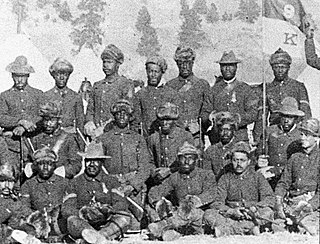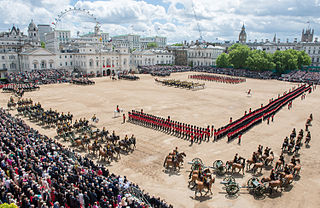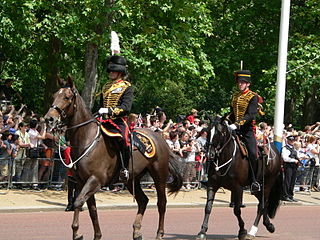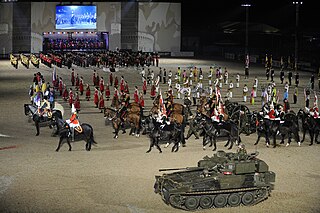Related Research Articles

The Royal Regiment of Artillery, commonly referred to as the Royal Artillery (RA) and colloquially known as "The Gunners", is one of two regiments that make up the artillery arm of the British Army. The Royal Regiment of Artillery comprises thirteen Regular Army regiments, the King's Troop Royal Horse Artillery and five Army Reserve regiments.

A troop is a military sub-subunit, originally a small formation of cavalry, subordinate to a squadron. In many armies a troop is the equivalent element to the infantry section or platoon. Exceptions are the US Cavalry and the King's Troop Royal Horse Artillery where a troop is a subunit comparable to an infantry company or artillery battery. Historically the remainder of the Royal Horse Artillery used the term troop in the same manner but they eventually aligned with the rest of the Royal Regiment of Artillery in referring to troops as subordinate to artillery batteries.

Trooping the Colour is a ceremonial event performed every year on Horse Guards Parade in London, United Kingdom, by regiments of Household Division, to celebrate the official birthday of the British sovereign. It is also known as the Sovereign's Birthday Parade. Similar events are held in other countries of the Commonwealth. In the UK, it is, with the State Opening of Parliament, one of the biggest events of the ceremonial calendar, and watched by millions on TV and on the streets of London.

The King's Troop, Royal Horse Artillery, is a ceremonial unit of the British Army, quartered at Woolwich. It is a mounted unit and all of its soldiers are trained to care for and drive teams of six horses, each team pulling a First World War-era QF 13-pounder gun; six teams are used in the unit's Musical Drive. The Troop's duties include firing salutes on royal and state occasions, participation in parades, and the duties of the King's Life Guard at Horse Guards for one month each year. The unit provides the gun carriage and team of black horses for state funerals. The unit is most often seen providing gun salutes on state occasions in Hyde Park, and Green Park.

Beating Retreat is a military ceremony dating to 17th-century England and was first used to recall nearby patrolling units to their castle.

The Royal Horse Artillery (RHA) was formed in 1793 as a distinct arm of the Royal Regiment of Artillery to provide horse artillery support to the cavalry units of the British Army. Although the cavalry link remained part of its defining character, as early as the Battle of Waterloo the RHA was sometimes deployed more along the lines of conventional field artillery, fighting from comparatively fixed positions.
The Household Cavalry Mounted Regiment (HCMR) is a cavalry regiment of the British Army tasked primarily with ceremonial duties. Part of the Household Division, it is classed as a regiment of guards, and carries out mounted ceremonial duties on State and Royal occasions. The HCMR is one of two operational units that form the Household Cavalry (HCav), the other being the Household Cavalry Regiment (HCR), a formation reconnaissance regiment, with front-line combat duties.

The 1st Cavalry Division was a regular Division of the British Army during the First World War where it fought on the Western Front. During the Second World War it was a first line formation, formed from Yeomanry Regiments. It fought in the Middle East before being converted to the 10th Armoured Division.

The Ordnance QF 13-pounder (quick-firing) field gun was the standard equipment of the British and Canadian Royal Horse Artillery at the outbreak of World War I.
7th Parachute Regiment, Royal Horse Artillery is a regiment of the Royal Artillery in the British Army. It currently serves in the field artillery role with 16 Air Assault Brigade Combat Team, and is equipped with the L118 Light Gun.

The Duke of Lancaster's Own Yeomanry (DLOY) was a yeomanry unit of the British Army from 1798 to 1992. Originally raised as part-time cavalry for home defence and internal security, the regiment sent mounted infantry to serve in the Second Boer War. During World War I it carried out mounted duties in Egypt and Palestine and on the Western Front. By 1917 the reserve units at home had become cyclists and the regiment serving on the Western Front joined an infantry battalion, seeing action at the Battle of Passchendaele, against the German Spring Offensive and in the final Allied Hundred Days Offensive. At the beginning of World War II the regiment gave up its horses and formed two regiments of medium artillery, which served in the Middle East, Italy and North West Europe. Postwar it became an armoured unit. Today its lineage is maintained by B Squadron, the Queen's Own Yeomanry.
The Sussex Yeomanry is a yeomanry regiment of the British Army dating from 1794. It was initially formed when there was a threat of French invasion during the Napoleonic Wars. After being reformed in the Second Boer War, it served in the First World War and the Second World War, when it served in the East African Campaign and the Siege of Tobruk. The lineage is maintained by 1 Field Troop, 579 Field Squadron (EOD), part of 101 (London) Engineer Regiment (Volunteers).
The Cavalry Division was formed in 1916 during First World War by units of the British Army and the British Indian Army stationed in India for service in Mesopotamia in the Mesopotamia Campaign. The Division was broken up in 1918, but its brigades then served independently.

Horses were widely used during the Napoleonic Wars for combat, patrol and reconnaissance, and for logistical support. Vast numbers were used throughout the wars. During the War of the Sixth Coalition, depletion of the French cavalry arm through attrition and loss of horse-producing allies to provide remounts contributed significantly to the gradual French defeat and downfall of the French Empire. During the Waterloo Campaign, the Armée du Nord had 47,000 horses: 25,000 cavalry, 12,000 for artillery, 10,000 for infantry and supply columns.

The Windsor Castle Royal Tattoo was an annual military tattoo held in the private grounds of Windsor Castle by permission of Queen Elizabeth II, from 2008 to 2011. The event's proceeds went to the Royal British Legion to help support recently returned troops from battle.
G Parachute Battery Royal Horse Artillery is a close support battery of 7th Parachute Regiment Royal Horse Artillery, part of the Royal Horse Artillery of the British Army, currently based in Merville Barracks in Colchester.
I Parachute Battery Royal Horse Artillery is the Headquarters battery of 7th Parachute Regiment Royal Horse Artillery, part of the Royal Horse Artillery of the British Army, currently based in Albemarle Barracks in Newcastle Upon Tyne.
General Sir Edward Charles Whinyates, was a senior British Army artillery officer.

A fanfare trumpet, also called a herald trumpet, is a brass instrument similar to but longer than a trumpet, capable of playing specially composed fanfares. Its extra length can also accommodate a small ceremonial banner that can be mounted on it.

The military bands of the United Kingdom are musical units that serve for protocol and ceremonial duties as part of the British Armed Forces. They have been the basis and inspiration for many military bands in the former British Empire and the larger Commonwealth of Nations as well as musical organizations in other countries. Military musical units with British influence include United States military bands, the Japan Ground Self-Defense Force Music Corps and the Military Band of Athens. British military bands are controlled by the military music departments of the three services that compose the armed forces. These include the Royal Marines Band Service, the Royal Corps of Army Music, and the Royal Air Force Music Services. British style brass bands and carnival bands were then and are currently inspired by the British Armed Forces and its brass bands, especially of the Army's regular and reserve formations, as they follow a similar format as it relates to brass and percussion instruments.